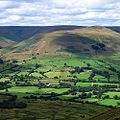Bocage

Bocage [boh-kahzh] is a Norman word which has found its way into both the French and English languages. It may refer to a small forest or a decoration that includes leaves. But most often it refers to pastures bordered by thick forest or hedges. The trees and hedges around the pastures or fields are planted in earth mounds.[1] Between the planted mounds are sunken lanes.[1] The word bocage forms part of the name for several towns in parts of Lower Normandy.[1] The term Bocage Normandy refers to the area around Saint-Lô and Vire.[1]
During World War II following the Allied Invasion of Normandy, the allies found themselves in 'hedgerow country' (bocage).[2] It was ideal for German troops to hide in and not be seen until it was too late.[2] The hedgerows were thick enough to hide tanks and artillery pieces. The final Allied breakout of the bocage into open country took over eight weeks of fighting.[3]
Bocage landscape
Bocage of the Cotentin Peninsula.
Path through bocage.
Rural landscape of semi-bocage.
Bocage Media
Bocage near Boulogne-sur-Mer, France
Chelsea porcelain factory candle-holder with bocage background, c. 1765
English bocage (Edale valley, Peak District)
References
- ↑ 1.0 1.1 1.2 1.3 Judy Smith, Holiday Walks in Normandy (Wilmslow: Sigma Leisure, 2001), p. 63
- ↑ 2.0 2.1 Leo Daugherty, The Battle of the Hedgerows: Bradley's First Army in Normady, June-July 1944 (St. Paul, MN: MBI Pub. Co., 2001), pp. 71-72
- ↑ William R. Buster, Time on target: the World War II memoir of William R. Buster (Frankfort, KY: Kentucky Historical Society, 1999), p. 83






